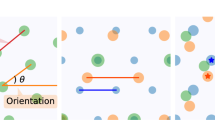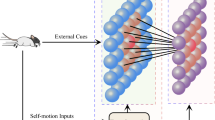Abstract
The grid cells of the dorsocaudal medial entorhinal cortex (dMEC) in rats show higher firing rates when the position of the animal correlates with the vertices of regular triangular tessellations covering the environment. Strong evidence indicates that these neurons are part of a path integration system. This raises the question, how such a system could be implemented in the brain. Here, we present a cyclically connected artificial neural network based on a path integration mechanism, implementing grid cells on a simulated mobile agent. Our results show that the synaptic connectivity of the network, which can be represented by a twisted torus, allows the generation of regular triangular grids across the environment. These tessellations share same spacing and orientation, as neighboring grid cells in the dMEC. A simple gain and bias mechanism allows to control the spacing and the orientation of the grids, which suggests that these different characteristics can be generated by a unique algorithm in the brain.
Preview
Unable to display preview. Download preview PDF.
Similar content being viewed by others
References
Hafting, T., Fyhn, M., Molden, S., Moser, M.B., Moser, E.I.: Microstructure of a spatial map in the entorhinal cortex. Nature 436(7052), 801–806 (2005)
Fyhn, M., Molden, S., Witter, M.P., Moser, E.I., Moser, M.B.: Spatial representation in the entorhinal cortex. Science 305(5688), 1258–1264 (2004)
Moser, M., Sargolini, F., Fyhn, M., Hafting, T., Witer, M., Moser, E.: Grid cells in medial entorhinal cortex: indications of columnar organization. Soc. Neurosci. Abstr. 198(4) (2005)
O’Keefe, J., Burgess, N.: Dual phase and rate coding in hippocampal place cells: theoretical significance and relationship to entorhinal grid cells. Hippocampus 15(7), 853–866 (2005)
Jeffery, K.J., Burgess, N.: A metric for the cognitive map: found at last? Trends Cogn Sci. 10(1), 1–3 (2006)
Parron, C., Save, E.: Evidence for entorhinal and parietal cortices involvement in path integration in the rat. Exp. Brain Res. 159(3), 349–359 (2004)
Braitenberg, V.: Vehicles, experiments in synthetic psychology. MIT Press, Cambridge (1984)
McNaughton, B., Barnes, C., Gerrard, J., Gothard, K., Jung, M., Knierim, J., Kudrimoti, H., Qin, Y., Skaggs, W., Suster, M., Weaver, K.: Deciphering the hippocampal polyglot: the hippocampus as a path integration system. J. Exp. Biol. 199, 173–185 (1996)
Samsonovich, A., McNaughton, B.: Path integration and cognitive mapping in a continuous attractor neural network model. J. Neurosci. 17(15), 5900–5920 (1997)
Stringer, S., Rolls, E., Trappenberg, T., de Araujo, I.: Self-organizing continuous attractor networks and path integration: two-dimensional models of place cells. Comput. Neural Syst. 13(4), 429–446 (2002)
Conklin, J., Eliasmith, C.: A controlled attractor network model of path integration in the rat. J. Comput. Neurosci. 18(2), 183–203 (2005)
Fuhs, M.C., Touretzky, D.S.: A spin glass model of path integration in rat medial entorhinal cortex. J. Neurosci. 26(16), 4266–4276 (2006)
O’Keefe, J., Dostrovsky, J.: The hippocampus as a spatial map. Preliminary evidence from unit activity in the freely-moving rat. Brain Res. 34(1), 171–175 (1971)
O’Keefe, J., Nadel, L.: The hippocampus as a cognitive map. Clarendon Press, Oxford (1978)
Wyss, R., König, P., Verschure, P.F.M.J.: A model of the ventral visual system based on temporal stability and local memory. PLoS Biol. 4(5), e120 (2006)
Author information
Authors and Affiliations
Editor information
Editors and Affiliations
Rights and permissions
Copyright information
© 2006 Springer-Verlag Berlin Heidelberg
About this paper
Cite this paper
Guanella, A., Verschure, P.F.M.J. (2006). A Model of Grid Cells Based on a Path Integration Mechanism. In: Kollias, S.D., Stafylopatis, A., Duch, W., Oja, E. (eds) Artificial Neural Networks – ICANN 2006. ICANN 2006. Lecture Notes in Computer Science, vol 4131. Springer, Berlin, Heidelberg. https://doi.org/10.1007/11840817_77
Download citation
DOI: https://doi.org/10.1007/11840817_77
Publisher Name: Springer, Berlin, Heidelberg
Print ISBN: 978-3-540-38625-4
Online ISBN: 978-3-540-38627-8
eBook Packages: Computer ScienceComputer Science (R0)




